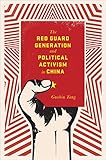The Red Guard Generation and Political Activism in China / Guobin Yang.
Material type: TextSeries: Studies of the Weatherhead East Asian Institute, Columbia UniversityPublisher: New York, NY : Columbia University Press, [2016]Copyright date: ©2016Description: 1 online resource (288 p.)Content type:
TextSeries: Studies of the Weatherhead East Asian Institute, Columbia UniversityPublisher: New York, NY : Columbia University Press, [2016]Copyright date: ©2016Description: 1 online resource (288 p.)Content type: - 9780231520485
- 9780231520485
- Interviews -- China -- Chongqing
- Political activists -- China -- Chongqing -- Interviews
- Political violence -- China -- History -- 20th century
- Political violence -- China -- Chongqing -- History -- 20th century
- Social movements -- China -- History -- 20th century
- Social movements -- China -- Chongqing -- History -- 20th century
- Urban-rural migration -- Political aspects -- China -- History -- 20th century
- Youth -- Political activity -- China -- History -- 20th century
- Youth -- Political activity -- China -- Chongqing -- History -- 20th century
- HISTORY / Asia / China
- 951.05 23
- DS796.C59257 Y36 2016
- DS775.7
- online - DeGruyter
- Issued also in print.
| Item type | Current library | Call number | URL | Status | Notes | Barcode | |
|---|---|---|---|---|---|---|---|
 eBook
eBook
|
Biblioteca "Angelicum" Pont. Univ. S.Tommaso d'Aquino Nuvola online | online - DeGruyter (Browse shelf(Opens below)) | Online access | Not for loan (Accesso limitato) | Accesso per gli utenti autorizzati / Access for authorized users | (dgr)9780231520485 |
Frontmatter -- CONTENTS -- NOTES ON DATA -- ACKNOWLEDGMENTS -- INTRODUCTION -- 1. VIOLENCE IN CHONGQING -- 2. FLOWERS OF THE NATION -- 3. THEORY AND DISSENT -- 4. ORDINARY LIFE -- 5. UNDERGROUND CULTURE -- 6. NEW ENLIGHTENMENT -- 7. FACTIONALIZED MEMORIES -- CONCLUSION -- NOTES -- BIBLIOGRAPHY -- INDEX -- Backmatter
restricted access online access with authorization star
http://purl.org/coar/access_right/c_16ec
Raised to be "flowers of the nation," the first generation born after the founding of the People's Republic of China was united in its political outlook and at first embraced the Cultural Revolution of 1966, but then split into warring factions. Investigating the causes of this fracture, Guobin Yang argues that Chinese youth engaged in an imaginary revolution from 1966 to 1968, enacting a political mythology that encouraged violence as a way to prove one's revolutionary credentials. This same competitive dynamic would later turn the Red Guard against the communist government.Throughout the 1970s, the majority of Red Guard youth were sent to work in rural villages, where they developed an appreciation for the values of ordinary life. From this experience, an underground cultural movement was born. Rejecting idolatry, these relocated revolutionaries developed a new form of resistance that signaled a new era of enlightenment, culminating in the Democracy Wall movement of the late 1970s and the Tiananmen protest of 1989. Yang's final chapter on the politics of history and memory argues that contemporary memories of the Cultural Revolution are factionalized along these lines of political division, formed fifty years before.
Issued also in print.
Mode of access: Internet via World Wide Web.
In English.
Description based on online resource; title from PDF title page (publisher's Web site, viewed 02. Mrz 2022)


